Abstract
This study investigated the effect of S-glutathionylation on passive force in skeletal muscle fibres, to determine whether activity-related redox reactions could modulate the passive force properties of muscle. Mechanically-skinned fibres were freshly obtained from human and rat muscle, setting sarcomere length (SL) by laser diffraction. Larger stretches were required to produce passive force in human fibres compared to rat fibres, but there were no fibre-type differences in either species. When fibres were exposed to glutathione disulfide (GSSG; 20 mM, 15 min) whilst stretched (at a SL where passive force reached ~ 20% of maximal Ca2+-activated force, denoted as SL20 % max), passive force was subsequently decreased at all SLs in both type I and type II fibres of rat and human (e.g., passive force at SL20 % max decreased by 12 to 25%). This decrease was fully reversed by subsequent reducing treatment with dithiothreitol (DTT; 10 mM for 10 min). If freshly skinned fibres were initially treated with DTT, there was an increase in passive force in type II fibres (by 10 ± 3% and 9 ± 2% in rat and human fibres, respectively), but not in type I fibres. These results indicate that (i) S-glutathionylation, presumably in titin, causes a decrease in passive force in skeletal muscle fibres, but the reduction is relatively smaller than that reported in cardiac muscle, (ii) in rested muscle in vivo, there appears to be some level of reversible oxidative modification, probably involving S-glutathionylation of titin, in type II fibres, but not in type I fibres.






Similar content being viewed by others
References
Alegre-Cebollada J et al (2014) S-glutathionylation of cryptic cysteines enhances titin elasticity by blocking protein folding. Cell 156:1235–1246. https://doi.org/10.1016/j.cell.2014.01.056
Allen DG, Lamb GD, Westerblad H (2008) Skeletal muscle fatigue: cellular mechanisms. Physiol Rev 88:287–332. https://doi.org/10.1152/physrev.00015.2007
Beckendorf L, Linke WA (2015) Emerging importance of oxidative stress in regulating striated muscle elasticity. J Muscle Res Cell Motil 36:25–36. https://doi.org/10.1007/s10974-014-9392-y
Bortolotto SK, Cellini M, Stephenson DG, Stephenson GM (2000) MHC isoform composition and Ca2+- or Sr2+-activation properties of rat skeletal muscle fibers. Am J Physiol Cell Physiol 279:C1564–C1577
Cleland WW (1964) Dithiothreitol, a new protective reagent for SH groups. Biochemistry 3:480–482
Dalle-Donne I, Rossi R, Giustarini D, Colombo R, Milzani A (2007) S-glutathionylation in protein redox regulation. Free Radic Biol Med 43:883–898. https://doi.org/10.1016/j.freeradbiomed.2007.06.014
Dogterom P, Mulder GJ, Nagelkerke JF (1989) Lipid peroxidation-dependent and -independent protein thiol modifications in isolated rat hepatocytes: differential effects of vitamin E and disulfiram. Chem Biol Interact 71:291–306
Dutka TL et al (2017) S-nitrosylation and S-glutathionylation of Cys134 on troponin I have opposing competitive actions on Ca2+ sensitivity in rat fast-twitch muscle fibers. Am J Physiol Cell Physiol 312:C316–C327. https://doi.org/10.1152/ajpcell.00334.2016
Grutzner A, Garcia-Manyes S, Kotter S, Badilla CL, Fernandez JM, Linke WA (2009) Modulation of titin-based stiffness by disulfide bonding in the cardiac titin N2-B unique sequence. Biophys J 97:825–834. https://doi.org/10.1016/j.bpj.2009.05.037
Halliwell B, Gutteridge JMC (2015) Free radicals in biology and medicine, 5th edn. Oxford University Press, Oxford
Higuchi M, Cartier LJ, Chen M, Holloszy JO (1985) Superoxide dismutase and catalase in skeletal muscle: adaptive response to exercise. J Gerontol 40:281–286
Hsin J, Strumpfer J, Lee EH, Schulten K (2011) Molecular origin of the hierarchical elasticity of titin: simulation, experiment, and theory. Annu Rev Biophys 40:187–203. https://doi.org/10.1146/annurev-biophys-072110-125325
Jaffrey SR, Snyder SH (2001) The biotin switch method for the detection of S-nitrosylated proteins. Sci STKE 2001:pl1. https://doi.org/10.1126/stke.2001.86.pl1
Ji LL, Fu R, Mitchell EW (1992) Glutathione and antioxidant enzymes in skeletal muscle: effects of fiber type and exercise intensity. J Appl Physiol 73:1854–1859. https://doi.org/10.1152/jappl.1992.73.5.1854
Kruger M, Linke WA (2011) The giant protein titin: a regulatory node that integrates myocyte signaling pathways. J Biol Chem 286:9905–9912. https://doi.org/10.1074/jbc.R110.173260
Lamb GD, Stephenson DG (2018) Measurement of force and calcium release using mechanically skinned fibers from mammalian skeletal muscle. J Appl Physiol 125:1105–1127. https://doi.org/10.1152/japplphysiol.00445.2018
Lamb GD, Westerblad H (2011) Acute effects of reactive oxygen and nitrogen species on the contractile function of skeletal muscle. J Physiol 589:2119–2127. https://doi.org/10.1113/jphysiol.2010.199059
Lamboley CR, Murphy RM, McKenna MJ, Lamb GD (2013) Endogenous and maximal sarcoplasmic reticulum calcium content and calsequestrin expression in type I and type II human skeletal muscle fibres. J Physiol 591:6053–6068. https://doi.org/10.1113/jphysiol.2013.265900
Lamboley CR, Wyckelsma VL, Dutka TL, McKenna MJ, Murphy RM, Lamb GD (2015) Contractile properties and sarcoplasmic reticulum calcium content in type I and type II skeletal muscle fibres in active aged humans. J Physiol 593:2499–2514. https://doi.org/10.1113/JP270179
Lamboley CR, Wyckelsma VL, McKenna MJ, Murphy RM, Lamb GD (2016) Ca2+ leakage out of the sarcoplasmic reticulum is increased in type I skeletal muscle fibres in aged humans. J Physiol 594:469–481. https://doi.org/10.1113/JP271382
Li S, Guo W, Schmitt BM, Greaser ML (2012) Comprehensive analysis of titin protein isoform and alternative splicing in normal and mutant rats. J Cell Biochem 113:1265–1273. https://doi.org/10.1002/jcb.23459
Linke WA (2018) Titin gene and protein functions in passive and active muscle. Annu Rev Physiol 80:389–411. https://doi.org/10.1146/annurev-physiol-021317-121234
Linke WA, Kruger M (2010) The giant protein titin as an integrator of myocyte signaling pathways. Physiology 25:186–198. https://doi.org/10.1152/physiol.00005.2010
Linke WA, Ivemeyer M, Olivieri N, Kolmerer B, Ruegg JC, Labeit S (1996) Towards a molecular understanding of the elasticity of titin. J Mol Biol 261:62–71
Maruyama K, Natori R, Nonomura Y (1976) New elastic protein from muscle. Nature 262:58–60
Mollica JP et al (2012) S-glutathionylation of troponin I (fast) increases contractile apparatus Ca2+ sensitivity in fast-twitch muscle fibres of rats and humans. J Physiol 590:1443–1463. https://doi.org/10.1113/jphysiol.2011.224535
O’Connell B, Stephenson DG, Blazev R, Stephenson GM (2004) Troponin C isoform composition determines differences in Sr2+-activation characteristics between rat diaphragm fibers. Am J Physiol Cell Physiol 287:C79–C87. https://doi.org/10.1152/ajpcell.00555.2003
Olsson MC, Kruger M, Meyer LH, Ahnlund L, Gransberg L, Linke WA, Larsson L (2006) Fibre type-specific increase in passive muscle tension in spinal cord-injured subjects with spasticity. J Physiol 577:339–352. https://doi.org/10.1113/jphysiol.2006.116749
Powers SK, Jackson MJ (2008) Exercise-induced oxidative stress: cellular mechanisms and impact on muscle force production. Physiol Rev 88:1243–1276. https://doi.org/10.1152/physrev.00031.2007
Prado LG, Makarenko I, Andresen C, Kruger M, Opitz CA, Linke WA (2005) Isoform diversity of giant proteins in relation to passive and active contractile properties of rabbit skeletal muscles. J Gen Physiol 126:461–480. https://doi.org/10.1085/jgp.200509364
Rivas-Pardo JA, Eckels EC, Popa I, Kosuri P, Linke WA, Fernandez JM (2016) Work done by titin protein folding assists muscle contraction. Cell Rep 14:1339–1347. https://doi.org/10.1016/j.celrep.2016.01.025
Saurin AT, Neubert H, Brennan JP, Eaton P (2004) Widespread sulfenic acid formation in tissues in response to hydrogen peroxide. Proc Natl Acad Sci USA 101:17982–17987. https://doi.org/10.1073/pnas.0404762101
Savarese M, Jonson PH, Huovinen S, Paulin L, Auvinen P, Udd B, Hackman P (2018) The complexity of titin splicing pattern in human adult skeletal muscles. Skelet Muscle 8:11. https://doi.org/10.1186/s13395-018-0156-z
Stephenson DG, Williams DA (1981) Calcium-activated force responses in fast- and slow-twitch skinned muscle fibres of the rat at different temperatures. J Physiol 317:281–302
Talbot JA, Morgan DL (1996) Quantitative analysis of sarcomere non-uniformities in active muscle following a stretch. J Muscle Res Cell Motil 17:261–268
Wang K, McClure J, Tu A (1979) Titin: major myofibrillar components of striated muscle. Proc Natl Acad Sci USA 76:3698–3702
Wang K, McCarter R, Wright J, Beverly J, Ramirez-Mitchell R (1991) Regulation of skeletal muscle stiffness and elasticity by titin isoforms: a test of the segmental extension model of resting tension. Proc Natl Acad Sci USA 88:7101–7105
Watanabe D, Kanzaki K, Kuratani M, Matsunaga S, Yanaka N, Wada M (2015) Contribution of impaired myofibril and ryanodine receptor function to prolonged low-frequency force depression after in situ stimulation in rat skeletal muscle. J Muscle Res Cell Motil 36:275–286. https://doi.org/10.1007/s10974-015-9409-1
Acknowledgements
We thank Heidy Flores for technical assistance. The monoclonal antibodies used in the present study were obtained from the Development Studies Hybridoma Bank, under the auspices of the NICHD and maintained by the University of Iowa, Department of Biological Sciences, Iowa City, IA 52242, USA. The monoclonal antibodies directed against adult human MHC isoforms (A4.840 and A4.74) used in the present study were developed by Dr. H. Blau and that for MHC IIx (6H1) was developed by Dr. C. Lucas. We thank the National Health and Medical Research Council of Australia for financial support (Grant No. 1085331).
Author information
Authors and Affiliations
Corresponding author
Additional information
Publisher's Note
Springer Nature remains neutral with regard to jurisdictional claims in published maps and institutional affiliations.
Rights and permissions
About this article
Cite this article
Watanabe, D., Lamboley, C.R. & Lamb, G.D. Effects of S-glutathionylation on the passive force–length relationship in skeletal muscle fibres of rats and humans. J Muscle Res Cell Motil 41, 239–250 (2020). https://doi.org/10.1007/s10974-019-09563-5
Received:
Accepted:
Published:
Issue Date:
DOI: https://doi.org/10.1007/s10974-019-09563-5




